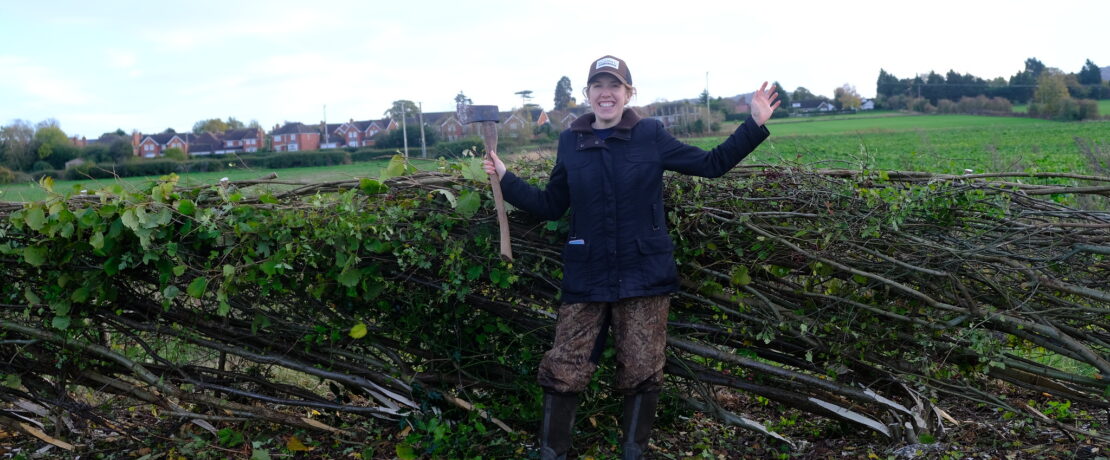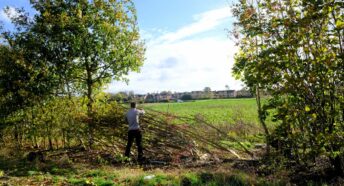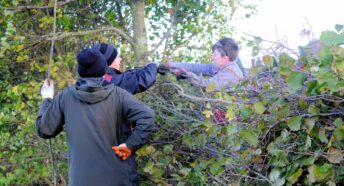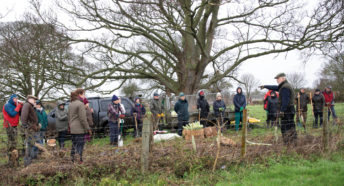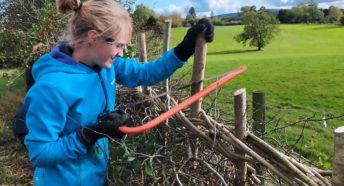A hedge I made earlier: Steph’s hedge of Blue Peter fame
Steph Boffey-Rawlings grew up on a mixed farm in Shropshire, and won a Blue Peter badge for a hedge she planted as a child. We caught up with her and her Dad about hedgerows and farming – and the joy of Blue Peter!
In the winter of 2022-3, several CPRE groups arranged a series of hedge laying and planting projects as part of CPRE’s Hedgerow Heroes project. One such project was led by CPRE Shropshire and took place at Cheshire Coppice, a mixed farm in rural Shropshire. Sarah, the branch manager, made us aware of a lovely story attached to the farm; one rooted in hedges and Blue Peter! We chatted with Steph and Steve Rawlings (her Dad, the landowner and farmer) to find out more.
Cheshire Coppice Farm
Cheshire Coppice is a farm 114 hectares in size (about 200 football fields). ‘I always describe it as a typical Shropshire mixed farm, with a good mix of pasture to arable,’ Steve tells us.
Hedgerows have been a staple on the farm for as long as Steve can remember. ‘With stock on the farm, we’ve always tended to leave them alone. Some hedges were removed in the 1970s to make the arable fields easier to farm,’ he says. ‘I’ve no idea how many kilometres of hedgerow there is on the farm, but it’s a lot!’
Steve adds that it’s not just the function of keeping animals safe that gives hedges their value. ‘The hedgerows are beneficial to game birds, and a variety of hedgerow inhabitants, like insects and other farmland birds. The farm used to host large numbers of partridge, but sadly habitat loss, heavy predation and house-building has reduced their numbers.’
Blue Peter
Like many people in the 80s and 90s, Steph grew up captivated and inspired by Blue Peter. ‘I used to love Blue Peter – the gardening section in the Blue Peter Garden, and the crafts,’ she says. ‘I remember all the cool things the presenters got up to and the competitions they ran.’
After a while, Steph decided to get in touch. ‘I remember writing my first letter and getting a response. I was hooked and really wanted a badge! After getting the normal badge, I got a silver and a birthday badge too. But then they launched a green badge, and I thought it would be perfect for me.’
Spurred by her desire to get the newly launched green badge, Steph decided to assist her Dad in planting a hedge on the family farm. For her, it was all just part of normal farm life. ‘I was helping Dad anyway, but I thought it would be a good example of the type of thing that would interest Blue Peter. I think it was probably tied into getting me a badge at Brownies, too!’
Steph and her Dad planted the hedge in the early 2000s and was a mixture of native species including hawthorn, spindle, guelder rose and hazel. It established well and supports a variety of wildlife, along with many other benefits, too.
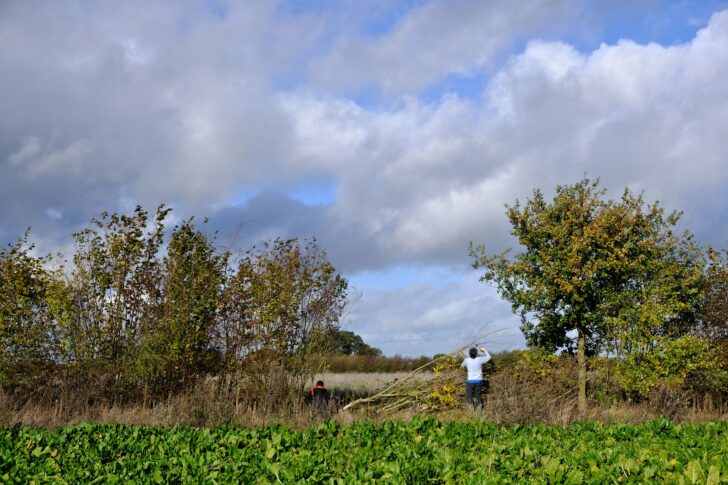
Growing up on a farm
Where we spend our formative years often has a big impact on who we become as a person. For Steph, growing up on a farm ignited a passion for the environment and the outdoors. ‘Growing up on the farm has completely shaped my entire life; my attitude toward people, animals, the environment, and challenges,’ she says. ‘I loved being outside. I remember making ‘perfume’ with flower petals, bird nests out of mud and grass, learning about different trees ….’
A lot of this inspiration came from helping her Dad with the daily tasks. ‘I’d help Dad with the farm jobs: feeding, checking the animals, lambing and beating on the family shoot.’
Now based in London, she carries these values with her in everything she does. ‘I’m massively into foraging nowadays, re-using what I can. My garden in London is full of things I’ve brought down from the farm to grow. I’ve got a freezer full of blackberries and other farm-foraged food.’ Last year, Steph attended the Chelsea Flower Show and saw another great link to Blue Peter, visiting their Blue Peter Garden of the future which looked specifically at soil health.
Her childhood has even inspired her career choice. Steph explains ‘I work in ground engineering, so land use, geography, geology, geomorphology, and sustainability all play a part in what I do now.’
A wildlife-friendly approach
Home to several ‘at risk’ species, Steve’s farm – and Steph’s childhood playground – has been managed with wildlife in mind since the 90s. ‘I entered the Arable Pilot Scheme and have been involved with stewardship schemes ever since.’ Steve says. Recently, he has worked closely with his advisor from Severn Trent Water, and now has substantial areas of land in the STEPS scheme (Severn Trent’s Environmental Protection Scheme).
Steve regularly sows bumblebird seed mixtures which help provide food for pollinators and birds. ‘A lot of birds have taken a bashing in recent years. But we hope the bumblebird mixes and naturalised margins help – particularly ground-nesting birds like skylarks and peewits. While bird flu has put a dent in numbers, Cheshire Coppice farm remains a firm favourite with birders.’
‘I have also had a small STEPS grant towards establishing herbal leys around the farm on what was arable land,’ Steve adds. ‘These complement the existing permanent pasture here already, and the forage is enjoyed by a small suckler cow herd, young stock and a flock of Easycare ewes.’
Hedgerow heroes
Steph actually returned to the farm to help CPRE Shropshire lay the hedge she and her father had planted. The hedgelaying workshops were ran by Really Rural. ‘The experience was amazing and I learned so much,’ she says. ‘I got to see the amazing work CPRE do nationally and it was interesting to hear the stories of other volunteers, and the passion they had for hedgerows.’
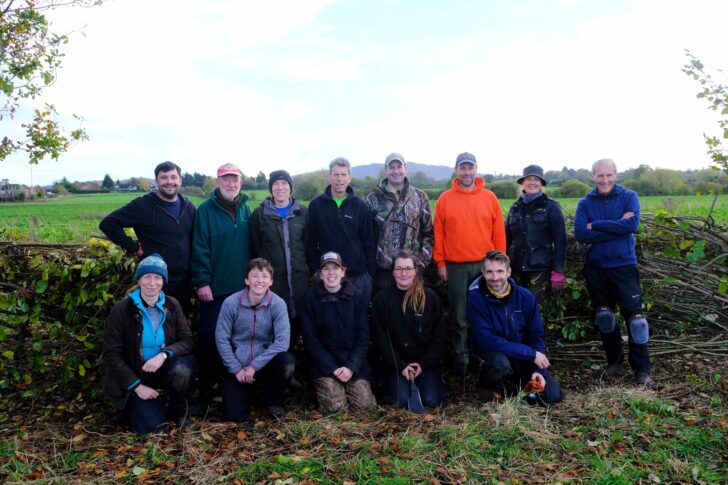
The volunteers were well-looked after following a hard day’s work too. ‘Dad and I made some goodies for everyone too. I made a blackberry cake with foraged blackberries from the farm.’
What CPRE does
At CPRE, we’ve campaigned for the government to set a target to plant more hedgerows. We hit a major milestone in this campaign in January 2023 when the government announced some solid planting targets by 2023. But, we’re always going to campaign for these incredible, life-giving, carbon-absorbing plants.
For the past two years, local CPREs up and down the country have planted or restored hundreds of miles of hedgerow. On Steve’s farm, CPRE Shropshire both created and restored native hedges, helping to boost the farm’s biodiversity. Find out more about the 2022-3 Hedgerow Hero projects here.
